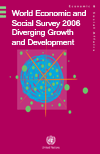World Economic and Social Survey 2006
Diverging Growth and Development
 By many measures, world inequality is high and rising. The main reason is that in the industrialized world the income level over the last five decades has grown steadily, while it has failed to do so in many developing countries. Not more than a few developing countries have been growing at sustained rates in recent decades, but these include, most notably, the world ??s two most populous countries, China and India. Considering that these two countries alone account for more than one third of world population, inequality across the globe is beginning to decline. When these countries are left out, however, international income inequality is seen as having continued to rise strongly from already high levels. The World Economic and Social Survey 2006 focuses on the causes and implications of the income divergence between countries.
By many measures, world inequality is high and rising. The main reason is that in the industrialized world the income level over the last five decades has grown steadily, while it has failed to do so in many developing countries. Not more than a few developing countries have been growing at sustained rates in recent decades, but these include, most notably, the world ??s two most populous countries, China and India. Considering that these two countries alone account for more than one third of world population, inequality across the globe is beginning to decline. When these countries are left out, however, international income inequality is seen as having continued to rise strongly from already high levels. The World Economic and Social Survey 2006 focuses on the causes and implications of the income divergence between countries.
Success in development depends both on country efforts and on an appropriate international environment. Greater income divergence is partly explained by a rising number of growth collapses. Countries with weak economic structures and institutions and low infrastructural and human development have less capacity to gain from integrating global markets. Such conditions make it more difficult for developing countries to grow out of poverty and reduce their vulnerability to global shocks. Hence, the greater the likelihood of growth collapses and conflict as global inequality rises. The problem of rising global inequality thus has an important bearing on the implementation of the United Nations development agenda. Failure to redress the tendency towards growing global inequality could thus have wide-ranging consequences for human development.
Sales No. E.06.II.C.1
ISBN 978-92-1-1553826
Download Full report in English

Follow Us